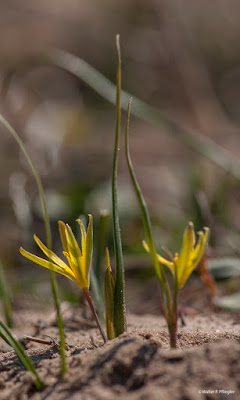Most of the isolated remaining natural landscapes of the South Nyírség Region are integrated into the Hajdúság Landscape Protection Area. Here, on the north-eastern part of the Great Hungarian Plain, a slight depression may be called a valley, and small elevations are referred to as hills. Hence the names of some protected areas: Valley of the Kék-Kálló, or Daru Hills of Bagamér, parts of the Natura 2000 Network. Pannonic sand steppes, sand dunes, Molinia meadows, and lowland hay meadows sustain a remarkable biodiversity here. I visited Bagamér in spring, when the rare endemic Hungarian Pasque Flowers are in blossom. Place: Bagamér. Date: 21-31.03.2015.
Ein Großteil der isolierten verbleibenden Naturlandschaften der Süd-Nyírség Region sind ins Hajdúság Landschaftschutzgebiet integriert. Hier, im nordöstlichen Teil der Großen Ungarischen Tiefebene, eine geringe Senke wird oft Tal genannt, und kleine Anhebungen sind als Hügeln bezeichnet. Daher stammen die Namen einiger geschützten Gebiete: Tal des Kék-Kálló, Daru Hügeln von Bagamér, Teile des Natura 2000 Netzwerkes. Hier, Pannonische Steppenwiesen auf Sand, Sanddünen, Pfeifengraswiesen und Magere Flachland-Mähwiesen aufrechterhalten eine bemerkenswerte Biodiversität. Ich habe Bagamér im Frühjar besucht, wann der seltene Endemit, die Ungarische Kuhschelle blüht. Ort: Bagamér. Datum: 21-31.03.2015.
A Dél-Nyírség izolált fennmaradó természetes tájainak nagy részét a Hajdúsági Tájvédelmi Körzet foglalja magába. Itt, az Alföld északkeleti részén egy kis mélyedés is lehet völgy, vagy egy alacsony dombocskát is nevezhetnek hegynek. Innen jönnek egyes védett területek nevei, mint a Kék-Kálló-völgy vagy a Bagaméri Daruhegyek, melyek a Natura 2000 hálózat részei. Pannon homoki gyepek, homokbuckák, kékperjés láprétek és kaszálórétek tartják fenn ezeken a területeken a fajok figyelemreméltó sokféleségét. Tavasszal kerestem fel Bagamért, mikor a ritka és bennszülött magyar kökörcsinek virágai díszlenek. Hely: Bagamér. Dátum: 2015.03.21-31.
Daru Hills of Bagamér:
Daru Hügeln von Bagamér:
Daruhegyek, Bagamér:
The Kék-Kálló:
Der Kék-Kálló:
A Kék-Kálló:
Geneigtes Spiralzahnmoos (Tortella cf. inclinata):
Egy szárazságtűrő mohafaj (Tortella cf. inclinata):
Tortula sp mosses:
Tortula sp Moose:
Tortula sp mohák:
Bristly Haircup (Polytrichum piliferum):
Glashaar-Haarmützenmoos (Polytrichum piliferum):Pillás szőrmoha (Polytrichum piliferum):
Hungarian Pasque Flower (Pulsatilla flavescens, earlier Pulsatilla hungarica):
Ungarische Kuhschelle (Pulsatilla flavescens, früher Pulsatilla hungarica):
Magyar kökörcsin (Pulsatilla flavescens, korábban Pulsatilla hungarica):
Black Locust Tree (Robinia pseudoacacia):
Gewöhnliche Robinie (Robinia pseudoacacia):
Fehér akác (Robinia pseudoacacia):

Claspleaf Pennycress (Microthlaspi perfoliatum):
Stängelumfassende Hellerkraut (Microthlaspi perfoliatum):
Galléros tarsóka (Microthlaspi perfoliatum):

Fivestamen Chickweed (Cerastium semidecandrum):
Sand-Hornkraut (Cerastium semidecandrum):
Békamadárhúr (Cerastium semidecandrum):

Vernal Sedge (Carex praecox):
Frühe Segge (Carex praecox):
Korai sás (Carex praecox):
Field Wood-rush (Luzula campestris):
Feld-Hainsimse (Luzula campestris):
Mezei perjeszittyó (Luzula campestris):
Yellow Star-of-Bethlehem (Gagea pratensis):
Wiesen-Gelbstern (Gagea pratensis):
Mezei tyúktaréj (Gagea pratensis):
Ramshorn snail (Planorbidae):
Tellerschnecke (Planorbidae):
Tányércsiga (Planorbidae):
A semiterrestrial amphipod (Orchestia cavimana):
Eine teilweise terrestrische Flohkrebsart (Orchestia cavimana):
Réti szöcskerák (Orchestia cavimana):
Water Springtail (Podura aquatica):
Schwarzer Wasserspringer (Podura aquatica):
vízi ugróvillás (Podura aquatica):
A seed bug (Aellopus atratus):
Borretsch-Wanze (Aellopus atratus):
Cigánybodobács (Aellopus atratus):
Acrotrichis sp featherwing beetle:
Acrotrichis sp Zwergkäfer:
Acrotrichis sp paránybogár:
Larva of the predaceous diving beetle Agabus bipustulatus:
Larve des Schwimmkäfers Agabus bipustulatus:
Az Agabus bipustulatus csíkbogár lárvája:Nursery Web Spider (Pisaura mirabilis):
Listspinne (Pisaura mirabilis):
Csodáspók (Pisaura mirabilis):

Alopecosa sp wolf spider:
Alopecosa sp Wolfspinne:
Alopecosa sp farkaspók:
Neriene sp sheetweb spider:
Neriene sp Baldachinspinne:
Neriene sp vitorláspók:

European fire-bellied toad (Bombina bombina):
Rotbauchunke (Bombina bombina):
Vöröshasú unka (Bombina bombina):
Rana sp eggs and tadpole:
Rana sp Eier und Kaulquappe:
Rana sp peték és ebihal:
Lichens on sandy soil:
Flechten auf Sandboden:Zuzmók homokos talajon:
The very rare Pokorny's Shield Lichen (Xanthoparmelia pokornyi):
Die sehr seltene Pokorny-Flechte (Xanthoparmelia pokornyi):
A nagyon ritka Pokorny-bodrány (Xanthoparmelia pokornyi):

A Cladonia species:
Eine Cladonia-Art:
Egy Cladonia-faj:
Another Cladonia species:
Eine andere Cladonia-Art:
Egy másik Cladonia-faj:
Unidentified fungus:
Unbsetimmter Pilz:
Meghatározatlan gomba:
Unbsetimmter Pilz:
Meghatározatlan gomba:



















































No comments:
Post a Comment